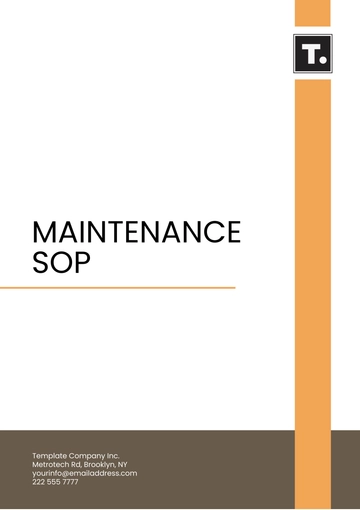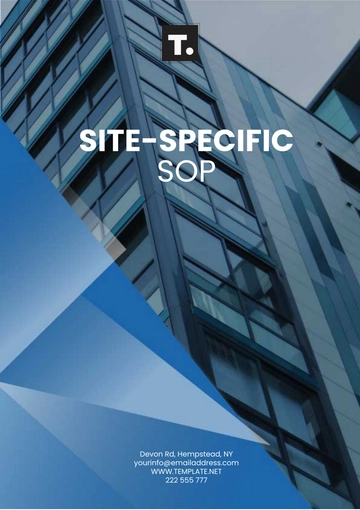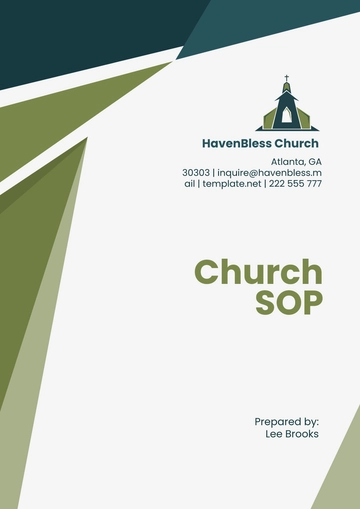Free Nursing Home SOP

I. Introduction
A. Purpose
The purpose of this Standard Operating Procedure (SOP) is to ensure the provision of high-quality care and services to our residents. By establishing clear guidelines and procedures for daily operations, we aim to maintain consistency, efficiency, and compliance with all regulatory standards. This SOP serves as a comprehensive reference for our staff, enabling them to understand their roles and responsibilities thoroughly and to perform their duties effectively and compassionately.
B. Scope
This SOP applies to all aspects of operation within our nursing home, encompassing resident care, staff management, health and safety protocols, facility maintenance, and regulatory compliance. It is designed to be a guide for current and future employees, ensuring that everyone working in our facility is aligned with our standards of care and operational excellence.
C. Definitions
For clarity and ease of understanding, we define the following terms used throughout this SOP:
Resident: An individual living in our nursing home receiving care and services.
Care Plan: A personalized and documented plan outlining the specific care needs and services provided to a resident.
Staff: Individuals employed at our nursing home, including medical professionals, support workers, and administrative personnel.
II. Organizational Structure
Our nursing home operates with a clear organizational structure designed to facilitate effective care delivery and efficient management of resources. Below is a table outlining the key roles within our organization and their primary responsibilities.
Role | Responsibilities |
|---|---|
Nursing Home Administrator | Oversees all operations, ensures compliance with regulations, and manages staff and resources. |
Director of Nursing | Leads the nursing staff, oversees resident care, and ensures the implementation of health care policies. |
Medical Director | Provides medical oversight, coordinates clinical services, and ensures quality of medical care. |
Registered Nurses (RNs) | Provide direct care to residents, administer medications, and monitor health conditions. |
Certified Nursing Assistants (CNAs) | Assist with daily living activities, ensure resident comfort, and support the nursing staff. |
Activities Director | Plans and implements recreational and social activities for residents to enhance their quality of life. |
Maintenance Supervisor | Manages the maintenance and upkeep of the facility, ensuring a safe and clean environment for residents. |
III. Admission Process
A. Criteria for Admission
Admission to our nursing home is guided by specific criteria to ensure that we can meet the needs of prospective residents. These criteria include:
Age 65 years or older or under 65 with specific care needs that we can accommodate.
A need for nursing or personal care on a residential basis.
A comprehensive assessment indicating that our facility can adequately meet the individual's care requirements.
B. Admission Process
The admission process is designed to be thorough and compassionate, ensuring a smooth transition for the resident. The process involves:
Gathering basic information and providing an overview of our services.
Conducting a pre-admission assessment.
Reviewing financial arrangements to ensure resident's care can be supported.
Reviewing and signing necessary paperwork.
C. Documentation Requirements for New Residents
To ensure a comprehensive understanding of each resident's needs and to comply with regulatory standards, we require the following documents for new admissions:
Completed Application Form
Medical History and Physical Examination Report
Proof of Financial Arrangement
Signed Consent Forms, including privacy, treatment, and emergency medical care consents
Copy of Advance Directives or Power of Attorney (if applicable)
IV. Resident Care
A. Daily Care Routines
Ensuring the well-being of our residents involves adhering to a structured daily care routine. This routine is designed to meet the physical, emotional, and social needs of each resident. Daily care routines include:
Morning care: Assistance with personal hygiene, dressing, and breakfast.
Medication administration: As per the prescribed schedule.
Activities: Both individual and group activities tailored to residents' preferences and abilities.
Meals: Breakfast, lunch, dinner, and snacks, provided in a communal dining area or in residents' rooms as needed.
Evening care: Assistance with personal hygiene and preparation for bedtime.
B. Medication Management Procedures
Our medication management procedures are designed to ensure the safe and accurate administration of medications to residents. The procedure includes:
All medications are verified with the resident's healthcare provider.
Medications are stored securely, complying manufacturer recommendations.
Medications are administered by qualified staff at correct times and dosages.
Every administration is documented in the resident's medical record.
Medication regimens are regularly reviewed by a pharmacist.
C. Emergency and Non-emergency Medical Care
In the event of a medical emergency, staff are trained to immediately assess the situation and, if necessary, call emergency services while providing basic first aid. All incidents are documented and reported according to our policy.
For non-emergency medical needs, residents are assessed by our nursing staff, and care is coordinated with their primary care physician or specialist. This includes routine medical check-ups, follow-up appointments, and consultations with healthcare providers.
D. Special Care
Residents requiring special care, such as those with dementia, mobility issues, or chronic illnesses, receive personalized care plans. These plans are developed in collaboration with healthcare providers, the resident, and their family. Special care includes tailored activities, therapy sessions, and interventions designed to enhance quality of life and well-being.
V. Staffing
A. Recruitment Procedures
Our commitment to high-quality care starts with the recruitment of skilled and compassionate staff. Our recruitment procedures include:
Open positions are advertised through various channels.
Applications are carefully reviewed and candidates are screened.
Selected candidates undergo a series of interviews with HR.
Comprehensive background checks are conducted.
New hires participate in an orientation program.
B. Training Program
To ensure our staff are well-equipped to provide the highest level of care, we offer ongoing training and professional development opportunities. The table below outlines our key training programs, their frequency, and duration.
Program | Frequency | Duration |
|---|---|---|
Orientation | Upon Hiring | 1 week |
Continuous Education | Annually | Varies |
Emergency Procedures | Bi-annually | 2 days |
Special Care Training | As Needed | Varies |
C. Scheduling
Scheduling is conducted with both the needs of our residents and the well-being of our staff in mind. We strive to maintain a balance that ensures adequate staffing levels at all times while allowing for flexibility and work-life balance. Schedules are created in advance, with consideration for peak times, special events, and individual staff availability and preferences. Our scheduling system also allows for the accommodation of personal emergencies, ensuring that both resident care and staff needs are met.
VI. Health and Safety
A. Infection Control Protocols
To prevent the spread of infections within our facility, we adhere to stringent infection control protocols. These measures are crucial for protecting our residents, staff, and visitors. Our protocols include:
Regular hand hygiene training and compliance monitoring.
Use of personal protective equipment (PPE) as required.
Routine disinfection of high-touch surfaces and communal areas.
Isolation procedures for residents with infectious diseases.
Influenza and pneumococcal vaccination programs for residents and staff.
B. Handling Medical Equipment
Safe handling of medical equipment is vital to ensure the health and safety of our residents. Our guidelines for handling medical equipment include:
Training for all staff on the correct use of medical equipment.
Regular maintenance and safety checks of equipment.
Proper cleaning and sterilization procedures.
Safe storage practices to prevent unauthorized use or damage.
Immediate reporting of any equipment malfunctions or safety concerns.
C. Emergency Evacuation
In the event of an emergency requiring evacuation, our facility has designated assembly points clearly marked throughout the premises. The evacuation process is tailored to the safety of our residents, especially those with mobility issues, ensuring:
Staff are trained in safe evacuation , including use of evacuation chairs.
Evacuation drills are conducted regularly to ensure preparedness.
Specific evacuation plans are in place for residents with special care needs.
Assembly points are located at safe distances from the building, easily accessible to emergency services.
D. Reporting and Managing Incidents
Reporting and managing incidents promptly and effectively is critical. Our procedure for incident reporting includes:
Immediate verbal notification to a supervisor or manager.
Completion of an incident report form within 24 hours of the incident.
Investigation of the incident to determine cause and preventive measures.
Follow-up actions to address any identified risks or issues.
VII. Nutrition and Hydration
A. Meal Planning and Preparation
Nutrition and hydration are integral to the well-being of our residents. Our guidelines for meal planning and preparation ensure:
Menus are designed by a qualified dietitian.
Meals are prepared using fresh, high-quality ingredients.
Meal times are regular and observed, with accommodations made for residents requiring assistance.
Special attention is given to the dining environment, promoting a social and enjoyable meal experience.
B. Special Dietary Requirements
Recognizing the diverse dietary needs of our residents, we accommodate various dietary requirements. The table below outlines common dietary needs and our approach to meeting them:
Requirement | Approach |
|---|---|
Diabetic | Low sugar, high fiber meals, with carbohydrate content tailored to individual needs. |
Gluten-Free | Gluten-free grains and alternatives, avoiding cross-contamination. |
Vegetarian | Nutrient-dense, plant-based meals that include a variety of proteins, vitamins, and minerals. |
Dysphagia | Smooth, pureed foods or thickened liquids, as appropriate, to prevent choking. |
C. Monitoring and Recording Food and Fluid Intake
Monitoring and recording the food and fluid intake of our residents is vital for identifying and addressing potential nutritional deficiencies or hydration issues. This process involves:
Regularly assessing each resident's nutritional and hydration status.
Keeping detailed records of daily food and fluid intake.
Collaborating with healthcare providers to adjust dietary plans as needed.
Providing additional support or interventions for residents with significant intake concerns.
VIII. Activities and Socialization
A. Importance
Activities and socialization play a crucial role in enhancing the quality of life for our residents. Engaging in regular activities promotes physical health, mental stimulation, and emotional well-being. It fosters a sense of community and belonging, reducing feelings of isolation and loneliness. Our commitment to providing a diverse range of activities ensures that all residents have the opportunity to participate in ways that are meaningful and enjoyable to them.
B. Resident Participation
Encouraging resident participation in activities is fundamental to their overall well-being. We achieve this by:
Offering a wide variety of activities catering to different interests and abilities.
Inviting residents to be part of the planning process.
Providing adaptive equipment and support for residents with physical limitations to ensure everyone can participate.
Regularly reviewing and adjusting activities based on resident feedback and participation levels.
C. Family and Community Engagement
Family and community engagement are integral to creating an inclusive and supportive environment. We facilitate this engagement through:
Hosting regular family nights and community events.
Encouraging volunteer programs.
Scheduling family meetings and updates.
Organizing outings and events that connect residents with the wider community, promoting a sense of belonging and social interaction.
IX. Facility Maintenance
Maintaining a clean, safe, and welcoming environment is paramount for the health and comfort of our residents and staff. The table below outlines key areas of our facility and the frequency of their cleaning and maintenance:
Facility Area | Frequency of Cleaning/Maintenance |
|---|---|
Resident Rooms | Daily cleaning, monthly maintenance checks |
Common Areas | Daily cleaning, weekly deep clean |
Dining Area | After each meal, daily deep clean |
Kitchen | After use, daily deep clean |
Bathrooms | Minimum twice daily, with checks every shift |
Outdoor Areas | Weekly cleaning, seasonal maintenance |
X. Resident Rights and Privacy
Respecting the rights and privacy of our residents is a cornerstone of our care. To ensure these rights are upheld, we implement the following policies:
Privacy of Information: All resident information is kept confidential, accessible only to authorized personnel.
Dignity and Respect: Residents are treated with dignity and respect at all times, with care plans tailored to respect their preferences and needs.
Decision Making: Residents are encouraged and supported in making informed decisions about their care and daily activities.
Freedom from Abuse: A zero-tolerance policy for any form of abuse, with immediate actions taken to protect residents.
Access to Care: Residents have the right to access medical and personal care that is free from discrimination.
Visitation Rights: Residents have the right to receive visitors of their choice, within reasonable hours, with accommodations made for privacy.
Grievance Process: A clear and accessible process for residents to voice grievances without fear of retaliation.
XI. Complaints and Grievances
A. Handling Complaints
We are committed to addressing complaints and grievances promptly and effectively, recognizing them as opportunities to improve our services. The process for handling complaints includes:
Receipt of Complaint: Complaints can be submitted verbally or in writing by residents, families, or staff.
Acknowledgment: All complaints are acknowledged within 24 hours of receipt, ensuring the complainant knows their concern is being taken seriously.
Investigation: A thorough investigation is conducted to understand the issue, involving interviews with relevant parties and review of documentation.
Resolution: Findings are reviewed, and appropriate actions are taken to resolve the complaint. This may involve corrective measures, policy changes, or other necessary steps to address the underlying issue.
Follow-Up: The complainant is informed of the outcome of the investigation and any actions taken. Follow-up is conducted to ensure the resolution is satisfactory and to prevent recurrence.
B. Resident and Family Communication
Clear and open communication with residents and their families is vital. To maintain this, we:
Provide regular updates on the resident's care and well-being.
Offer multiple channels for communication.
Ensure that a staff member is always available.
Organize family meetings at regular intervals or as needed to discuss care plans, changes in health status, or any other concerns.
XII. Quality Assurance
A. Continuous Improvement Programs
Our commitment to quality care is underpinned by continuous improvement programs, which include:
Regular training and development opportunities for staff.
Implementation of best practices based on the latest research.
Feedback mechanisms for residents, families, and staff.
Review and update of policies and procedures to reflect improvements and changes in care standards.
B. Auditing and Monitoring of Services
To ensure the highest standards of care and service are maintained, we conduct:
Regular internal audits of all aspects of our operations.
External audits by regulatory bodies or independent auditors, as required.
Continuous monitoring of care practices and resident satisfaction.
Regular meetings to review audit findings and implement necessary improvements.
C. Staff Performance Evaluations
Staff performance evaluations are conducted to ensure that all team members meet our high standards of care and professionalism. The evaluation process includes:
Annual performance reviews, with interim evaluations for new staff or following a promotion.
Criteria based on job performance, adherence to policies, resident feedback, and professional development.
A collaborative review process, where staff have the opportunity to discuss their achievements, challenges, and goals.
Development plans to address any areas of improvement and to support career progression.
XIII. Regulatory Compliance
Ensuring compliance with regulatory standards is fundamental to providing safe and high-quality care. Our commitment to regulatory compliance involves adhering to all applicable laws and regulations, conducting regular training for staff on legal and regulatory requirements, and implementing policies and procedures that reflect current best practices in long-term care. We continuously monitor changes in legislation and regulatory guidance to ensure our practices remain compliant. Key U.S. laws and regulations relevant to our operations include:
Health Insurance Portability and Accountability Act (HIPAA)
Americans with Disabilities Act (ADA)
Occupational Safety and Health Administration (OSHA) regulations
Centers for Medicare & Medicaid Services (CMS) regulations
The Patient Self-Determination Act (PSDA)
XIV. End-of-Life Care
A. Palliative and Hospice Care Protocols
Our approach to end-of-life care is centered on providing comfort, dignity, and respect to residents facing terminal illness. Our palliative and hospice care protocols include:
Comprehensive pain and symptom management tailored to individual needs.
Emotional and spiritual support for residents and their families.
Coordination with hospice agencies to provide additional services as needed.
Regular assessment and adjustment of care plans to ensure comfort and quality of life.
B. Support for Residents and Families
Supporting both residents and their families during the end-of-life phase is a priority. We provide:
Counseling services to help cope with emotional and psychological aspects.
Information and education about the dying process and what to expect.
Assistance with making arrangements for after death.
Opportunities for families to spend quality time with their loved ones in a comfortable and private setting.
C. Handling the Death of a Resident
The passing of a resident is handled with sensitivity and respect. Our procedure includes:
Notification of resident's physician and family immediately upon death.
Coordination with a funeral home of the family's choice.
Assistance to the family with any necessary paperwork and support.
Conducting a review of the resident's care leading up to their death.
Providing support and counseling for other residents and staff affected by the loss.
- 100% Customizable, free editor
- Access 1 Million+ Templates, photo’s & graphics
- Download or share as a template
- Click and replace photos, graphics, text, backgrounds
- Resize, crop, AI write & more
- Access advanced editor
Find the Nursing Home SOP Template from Template.net, your foundation for operational excellence. This template, designed to be both editable and customizable, streamlines standard operating procedures, ensuring consistent high-quality care. Effortlessly adjust content in our AI Editor tool, making it an indispensable tool for maintaining best practices in nursing home management.





























